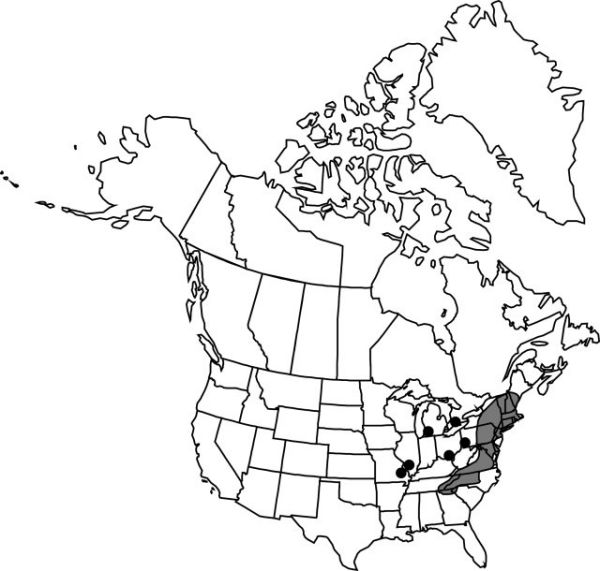Difference between revisions of "Isotria medeoloides"
Fl. Tellur. 4: 47. 1838.
FNA>Volume Importer |
FNA>Volume Importer |
||
| Line 11: | Line 11: | ||
|name=Arethusa medeoloides | |name=Arethusa medeoloides | ||
|authority=Pursh | |authority=Pursh | ||
| + | |rank=species | ||
|publication_title=Fl. Amer. Sept. | |publication_title=Fl. Amer. Sept. | ||
|publication_place=2: 591. 1814 | |publication_place=2: 591. 1814 | ||
| Line 17: | Line 18: | ||
|name=Pogonia affinis | |name=Pogonia affinis | ||
|authority=Austin ex A. Gray | |authority=Austin ex A. Gray | ||
| + | |rank=species | ||
}} | }} | ||
|hierarchy=Orchidaceae;Orchidaceae subfam. Vanilloideae;Orchidaceae tribe Vanilleae;Orchidaceae (tribe Vanilleae) subtribe Pogoniinae;Isotria;Isotria medeoloides | |hierarchy=Orchidaceae;Orchidaceae subfam. Vanilloideae;Orchidaceae tribe Vanilleae;Orchidaceae (tribe Vanilleae) subtribe Pogoniinae;Isotria;Isotria medeoloides | ||
| Line 61: | Line 63: | ||
-->{{#Taxon: | -->{{#Taxon: | ||
name=Isotria medeoloides | name=Isotria medeoloides | ||
| − | |||
|authority=(Pursh) Rafinesque | |authority=(Pursh) Rafinesque | ||
|rank=species | |rank=species | ||
| Line 76: | Line 77: | ||
|publication year=1838 | |publication year=1838 | ||
|special status= | |special status= | ||
| − | |source xml=https://jpend@bitbucket.org/aafc-mbb/fna-data-curation.git/src/ | + | |source xml=https://jpend@bitbucket.org/aafc-mbb/fna-data-curation.git/src/f50eec43f223ca0e34566be0b046453a0960e173/coarse_grained_fna_xml/V26/V26_1044.xml |
|subfamily=Orchidaceae subfam. Vanilloideae | |subfamily=Orchidaceae subfam. Vanilloideae | ||
|tribe=Orchidaceae tribe Vanilleae | |tribe=Orchidaceae tribe Vanilleae | ||
Revision as of 20:44, 16 December 2019
Herbs, singly or rarely in small clumps, short-rhizomatous, 4–25 cm. Stems pale grayish green, glaucous; scales 2–4, near soil line, white to light green. Leaves pale grayish green; blade elliptic-obovate, 17–85 × 8–40 mm, apex acuminate, glaucous when young. Flowers subsessile, without nectar and fragrance; sepals arching, green to light green, linear-oblanceolate, 12–25 × 2–3 mm; petals light green, oblanceolate, 12–18 × 2–4 mm; lip light yellowish green to pale greenish white, streaked with green, obovate, 11–16 × 4–5 mm, lateral lobes narrowly triangular, margins involute, middle lobe rounded, margins slightly revolute, undulate; callus yellowish green, longitudinal, becoming elongate, with fleshy, wartlike papillae toward apex; column 8–10 mm; ovary 10–15 mm; rostellar flap reduced. Capsules 12–28 × 2–10 mm; pedicel of mature capsule elongating to 5–17(–20, rarely) mm. 2n = 18.
Phenology: Flowering May–Jun; capsules mature fall.
Habitat: Acidic soils, in dry to mesic 2d-growth, deciduous or deciduous-coniferous forests, typically light to moderate leaf litter, open herb layer (occasionally in dense ferns), moderate to light shrub layer, relatively open canopy, frequently on flats or slope bases near canopy breaks
Elevation: 30–1000 m
Distribution

Ont., Conn., Del., Ga., Ill., Maine, Md., Mass., Mich., Mo., N.H., N.J., N.Y., N.C., Ohio, Pa., R.I., S.C., Tenn., Vt., Va.
Discussion
Isotria medeoloides should be sought in Alabama, Arkansas, Indiana, Kentucky, and West Virginia.
Isotria medeoloides is self-pollinating (L. A. Mehrhoff 1983). Nonflowering plants commonly have a white, arrested floral bud (1–2 mm).
of conservation concern